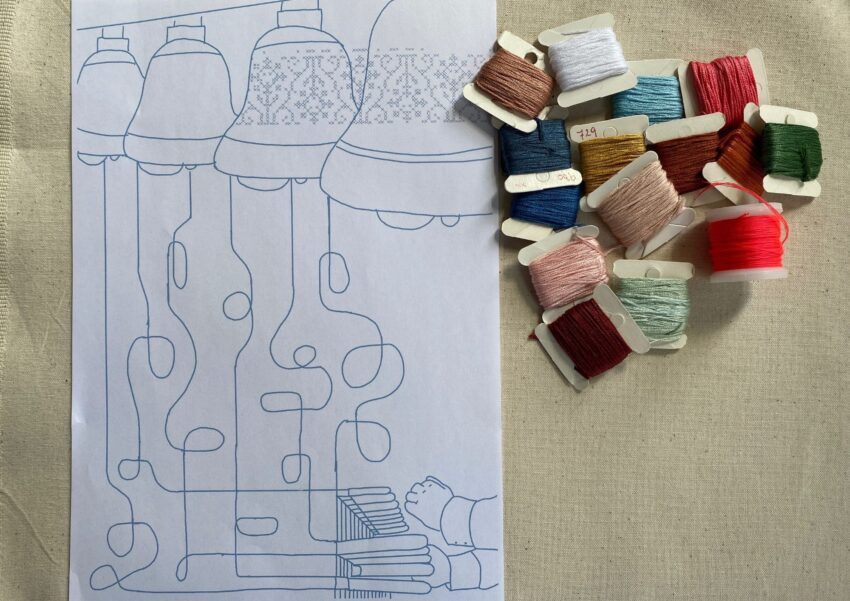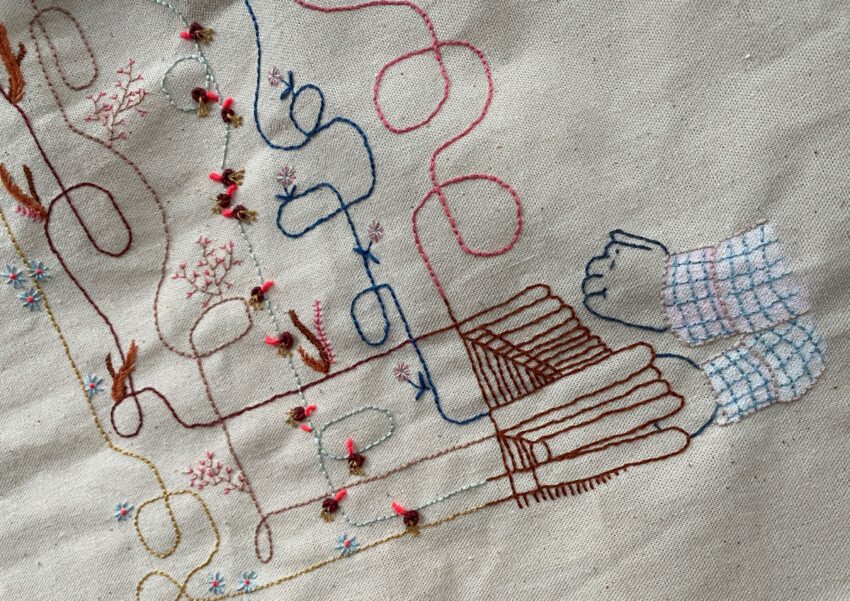Embroidery artists to picture living heritage

As part of our Journeys to explore encounters of living heritage and tourism, we have invited embroidery artists to depict the living heritage in each of the 5 countries involved.
It has been an experiment to seek ways of visualising living heritage practices:
How can we create images to be at the same time illustrative, appealing and truthful for the practices in focus? After all, it is about creating an image which communities can recognise and identify themselves, while at the same time being enlightening and attractive images for outsiders and visitors.
To complete this experiment, we set to work on it together with embroidery artists. Embroidery traditions are being practised in many countries, each with their own variations in visual language, use of colour, motifs and linked meanings, etc. It gives an extra dimension to the experiment of visualising living heritage to do so via another -widespread and culturally diversified- ICH practice: embroidery.
Reflecting on the ways to depict living heritage, the project team proposed to let the different embroidery artists work fully free regarding the style and techniques they’d wish to apply, but to set a minimal base of aspects that should be present in any work to test what that would bring to the image of the heritages.
Thus it was asked to the embroiderer to
a/ present the living heritage practice in action
b/ with a human being involved or doing this practice, and
c/ to present this ‘in context’: e.g. relating to the cultural space where it takes place, the instruments and objects that are involved, etc …
Indeed, when tourism destinations and their heritage are being represented, this is almost always done through typical images of monuments, natural landscape, and/or the material aspects of culture such as traditional costumes, food, art or craft objects. Hence, the exercise consisted of exploring how we can bring the living, dynamic and human dimensions of the ICH related to a destination more in focus in such tourism imaging.
We will happily present you the work process of each embroiderer and our take-aways from this experience in the coming time.

Celebrating Carillon Culture Through Embroidery: The Work of Eva Verbruggen
The first experiment to seek ways of visualising living heritage practice together with embroidery artist we introduce here, is the work by Eva Verbruggen, who created an embroidery piece on the carillon culture in Belgium.
Eva is a textile and embroidery artist working and living in Antwerp in Belgium. Eva is known for her bright and colourful textile creations, often with a sense of humour, and peppered with inspiration from art, design and reinterpreting tradition. Eva is a teacher, but instead of being in the classroom she got to combine both education and textile creation in her textile workshop, where she’s making as well as teaching and transmitting textile skills and practices.
After being introduced to the carillon culture via the Belgian project partner (Workshop intangible heritage, the ICH organisation in Flanders region), Eva took a deep dive into carillon imagery. Without much time or budget to involve the practitioners directly, her research started off by studying photographs of carillonneurs at work, collected via carillonneurs and the Flemish ICH website immaterieelerfgoed.be where heritage practitioners describe and present their ICH on their own terms.
This introductory, textual and visual exploration could lay the foundation of her artistic process.
Once she had immersed herself in the carillon's heritage and visual aspects, Eva began sketching different ideas. Early on, she opted to feature two key elements: the hands of the carillonneurs, representing the human element in the heritage, and the bells, symbolising the context of the carillon: the musical dimension and the cultural space of bell towers.
More challenging for Eva was how to creatively and meaningfully connect these two elements into one cohesive imagery. Through several iterations, Eva found the answer. She created a design where the hands and bells interact in a fluid and visually compelling way, highlighting both the skill of the carillonneurs and the significance of the bells in their cultural context. To invigorate their connectivity in the image, Eva chose a harmonious colour palette joining both the human and mechanical and spatial aspects of the practice.

Using acrylic paint, Eva carefully added colour to the design before embroidering it. She began by stitching the main lines, followed by intricate floral details. Floral details are a recurring motif in Eva’s work, but serving here to highlight the meaningful, living and connecting dimension of the music being created through the practice of the carillonneur’s hands and creating a musical landscape that embraces and involves the people present in the urban surroundings.
As a final touch, Eva added cross-stitch patterns to the bells, inspired by the inscriptions and motifs that often are present on bells. This gave the embroidery a graphic, textured finish, reminiscent of traditional bell motifs.
Eva Verbruggen sees her work as a celebration of the carillon as a living tradition, capturing both its technical mastery and its deep-rooted cultural outreach and significance. It highlights the human connection to this musical practice, which makes the tradition continue to resonate to this day and into the future.